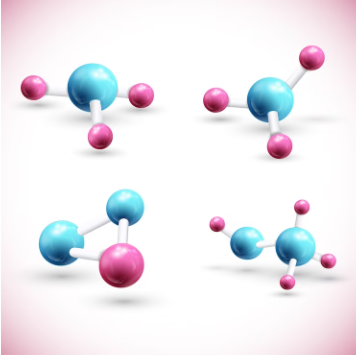
The MCAT Organic Chemistry Content: Your Ultimate Guide
When it comes to MCAT organic chemistry, many students struggle with difficult concepts, especially stereochemistry and reaction mechanisms. It can feel like getting lost in a maze of carbon atoms! But don’t worry. Our content guide is here to help you conquer this challenging subject and succeed on test day.
We’ve gathered valuable knowledge, study strategies, and practical tips to boost your confidence and skills in MCAT Organic Chemistry.
Say goodbye to confusion and hello to clarity as we unravel the mysteries of bonding, functional groups, and more.
Key Concepts You Should Know
Let’s quickly explore some fundamental concepts of organic chemistry MCAT section:
Electronegativity
Electronegativity refers to the ability of an atom to attract electrons in a chemical bond. It influences molecules’ polarity and electron density distribution within them.
Hybridization
Hybridization involves mixing atomic orbitals to form new hybrid orbitals. It helps explain the molecular geometry and bonding properties of organic compounds.
Resonance
Resonance occurs when a molecule can have different arrangements of electrons, represented by resonance structures. It plays a vital role in understanding the stability and reactivity of organic compounds.
Molecular Orbitals

Molecular orbitals are formed by the overlap of atomic orbitals within a molecule. These orbitals determine the distribution of electrons and contribute to the properties and behavior of organic compounds.
Essential Topics of Organic Chemistry MCAT Section
Bonding and Molecular Structure
To understand the behavior and properties of organic compounds, you must grasp the principles of bonding and the molecular structure of atoms. Here are some key insights:
Covalent Bonding:
Covalent bonds involve the sharing of electrons between atoms. These bonds are vital for forming stable organic molecules.
Lewis Structures:
Lewis structures visually represent how atoms are connected and how electrons are distributed in a molecule. They help predict molecular geometry and bonding patterns.
Intermolecular Forces:
Intermolecular forces, such as hydrogen bonding, dipole-dipole interactions, and London dispersion forces, affect organic compounds’ physical properties and behavior, including boiling and melting points, solubility, and volatility.
Molecular Geometry: The arrangement of atoms in a molecule determines its shape and spatial orientation. Understanding molecular geometry is crucial for predicting the reactivity and behavior of organic compounds.
Stereochemistry and Isomerism
Stereochemistry deals with the three-dimensional arrangement of atoms in molecules. Here are valuable insights on stereochemistry and isomerism:
Chirality:
Chirality refers to the property of a molecule that is not superimposable on its mirror image. Chiral molecules have different spatial arrangements of atoms and exhibit optical activity.
Enantiomers:
Enantiomers are pairs of chiral molecules that are mirror images of each other. They have identical physical and chemical properties, except for their interaction with plane-polarized light.
Diastereomers:
Diastereomers are stereoisomers that are not mirror images of each other. They have distinct physical and chemical properties and can exhibit different reactivity in reactions.
Functional Groups and Their Properties
Functional groups are pivotal in organic chemistry as they are responsible for organic compounds’ unique reactivity and properties. Understanding functional groups is essential for analyzing and predicting chemical reactions and understanding the behavior of organic compounds in biological systems. Here’s a detailed account of functional groups and their properties:
Alcohols:
Alcohols are characterized by a hydroxyl (-OH) group. They exhibit properties such as hydrogen bonding and acidity (in the case of phenols) and undergo reactions such as oxidation, dehydration, and esterification.
Aldehydes and Ketones:
Aldehydes and ketones contain a carbonyl group (C=O), with aldehydes having the carbonyl group at the end of a carbon chain. They are involved in nucleophilic addition reactions and oxidation reactions and form derivatives such as hemiacetals and acetals.
Carboxylic Acids:
Carboxylic acids possess a carboxyl group (-COOH). They exhibit acidity, undergo nucleophilic substitution reactions, and form esters, amides, and salts.
Esters:
Esters are derived from carboxylic acids and alcohols, containing an -OR group. They participate in hydrolysis reactions, Fischer esterification, and transesterification.
Amines:
Amines are characterized by nitrogen (-NH2) or nitrogen in a cyclic structure. They act as bases, form salts, undergo substitution reactions, and participate in reductive amination and acylation reactions.
Amides:
Amides consist of carbonyl and amino groups (-CONH2). They are involved in hydrolysis reactions, form hydrogen bonds, and can act as both acids and bases.
Understanding the properties and reactivity of these functional groups is crucial for recognizing them in complex molecules, predicting their behavior in reactions, and applying this knowledge to solve MCAT questions effectively.
Reaction Mechanisms and Kinetics
Reaction mechanisms provide a detailed understanding of how chemical reactions occur at the molecular level. They involve the step-by-step movement of electrons and the formation of intermediates. Here’s an elaboration on reaction mechanisms and kinetics:
Reaction Intermediates:
These are transient species that are formed and consumed during a chemical reaction. Examples include carbocations, carbanions, and free radicals. Understanding their stability and reactivity is vital in predicting reaction outcomes.
Catalysts:
Catalysts are substances that increase the rate of a chemical reaction without being consumed. They participate in reaction mechanisms by lowering the activation energy, providing an alternative reaction pathway, and increasing the reaction rate.
Rate-Determining Steps:
The rate-determining step is the slowest in a reaction mechanism and determines the overall rate of the reaction. Identifying the rate-determining step is essential for understanding a reaction’s kinetics and rate laws.
Organic Reaction Types:
Organic reactions encompass many transformations, including substitution, elimination, addition, and rearrangement reactions. Each reaction type has specific mechanisms and factors that influence their rates.
Nucleophiles and Electrophiles:
Nucleophiles are electron-rich species that donate a pair of electrons, whereas electrophiles are electron-deficient species that accept a pair of electrons. Understanding their role in reaction mechanisms helps predict reaction outcomes.
By comprehending reaction mechanisms and kinetics, you can deduce how reactants transform into products, anticipate the effects of different reagents and conditions, and make informed decisions when solving MCAT questions related to organic chemistry reactions.
Organic Synthesis and Retrosynthesis
Organic synthesis involves the strategic planning and execution of reactions to obtain desired target molecules. It is a crucial skill in organic chemistry, enabling chemists to construct complex compounds from simpler starting materials.
Retrosynthesis, on the other hand, is a valuable approach that involves working backward from the target molecule to identify the necessary precursors and steps. Here’s a detailed exploration of organic synthesis and retrosynthesis:
Overview of Organic Synthesis:
Organic synthesis aims to design efficient routes to synthesize complex molecules. It involves selecting appropriate reactions, considering reactivity and selectivity, and optimizing reaction conditions. Synthesis strategies include functional group interconversions, carbon-carbon bond formations, and protecting group manipulations.
Retrosynthetic Analysis:
Retrosynthesis involves breaking down a target molecule into simpler precursor molecules through the disconnections of bonds. This approach simplifies the synthesis process by identifying key steps and functional group transformations required to achieve the desired product.
Functional Group Interconversions:
Functional group interconversions are central to organic synthesis. They involve transforming one functional group into another by selectively modifying specific bonds. Examples include conversions between alcohols, carbonyl compounds, amines, and carboxylic acids.
Protecting Groups:
Protecting groups are temporary modifications applied to specific functional groups to prevent unwanted reactions during complex synthesis. They allow specific molecule regions to be chemically inert while other transformations occur elsewhere.
Synthetic Equivalents:
Synthetic equivalents refer to alternative reagents or functional groups that can be used interchangeably in organic synthesis. They allow chemists to choose the most appropriate reagent for a specific transformation based on availability or reaction conditions.
By mastering organic synthesis and retrosynthesis, you can design efficient routes to complex molecules, anticipate challenges, and make strategic decisions during the synthesis process. This knowledge empowers you to solve synthesis-related questions on the MCAT with confidence.
Acids and Bases
Understanding acid-base concepts is fundamental to organic chemistry. Acids donate protons (H+), while bases accept protons. Here’s an in-depth exploration of acids and bases in organic chemistry:
Acid-Base Theories:
Two prominent acid-base theories are the Bronsted-Lowry and Lewis theories. The Bronsted-Lowry theory defines an acid as a proton (H+) donor and a base as a proton acceptor. The Lewis theory expands the definition of acids to include electron pair acceptors and bases as electron pair donors.
pKa Values and Acid/Base Strength:
The pKa value indicates the acidity of a compound, with lower pKa values corresponding to stronger acids. Understanding pKa values allows the prediction of relative acid/base strengths and the direction of acid/base reactions.
Factors Influencing Acidity and Basicity:
Several factors influence the acidity or basicity of a compound. These factors include atom electronegativity, resonance effects, inductive effects, hybridization, and solvation effects.
Acid-Base Reactions:
Organic acid-base reactions involve proton transfer between acids and bases. Examples include protonation, deprotonation, and nucleophilic attacks. Understanding these reactions is crucial for predicting reaction outcomes and identifying acidic or basic sites in molecules.
Acidic and Basic Functional Groups:
Different functional groups exhibit varying levels of acidity or basicity. Examples of acidic functional groups include carboxylic acids and phenols, while basic functional groups include amines and alkoxides.
Acquiring a solid foundation in acid-base concepts allows you to recognize acidic or basic properties in molecules, predict reaction outcomes, and interpret experimental results in organic chemistry. This knowledge is valuable for solving acid-base-related questions on the Organic Chemistry MCAT section.
Spectroscopy
Spectroscopy is a powerful tool for analyzing the structure and properties of organic compounds. It involves the interaction of molecules with electromagnetic radiation, enabling the identification and characterization of functional groups and molecular environments. Here’s a detailed exploration of spectroscopy in organic chemistry:
UV-Vis Spectroscopy:
UV-Vis spectroscopy involves the absorption of ultraviolet and visible light by organic compounds. It provides information about conjugated systems, chromophores, and electronic transitions, aiding in compound identification and molecular structure determination.
Infrared (IR) Spectroscopy:
IR spectroscopy analyzes the absorption of infrared radiation by organic compounds. It provides valuable information about functional groups and the presence of specific bonds, enabling the identification of compounds and structural analysis.
Nuclear Magnetic Resonance (NMR) Spectroscopy:
NMR spectroscopy is widely used for structural determination in organic chemistry. It exploits the magnetic properties of atomic nuclei to provide information about molecules’ connectivity, environment, and stereochemistry. Common NMR techniques include proton (1H-NMR) and carbon-13 (13C-NMR) spectroscopy.
Mass Spectrometry (MS):
Mass spectrometry determines the molecular mass and provides information about the fragmentation pattern of organic compounds. It aids in compound identification, determination of molecular formulas, and analysis of structural features.
Interpretation of Spectral Data:
Analyzing spectral data involves identifying characteristic peaks, understanding peak shifts and splitting patterns, and correlating spectral features with specific functional groups or structural motifs. It requires knowledge of spectroscopic techniques and an understanding of the principles underlying each method.
Mastering spectroscopy empowers you to interpret experimental data, deduce structural information, and identify functional groups and molecular environments in organic compounds. This knowledge is invaluable for solving spectroscopy-related questions on the MCAT.
Biochemistry and Biomolecules
Biochemistry explores the chemical processes and molecules that occur within living organisms. It is an essential area of study within organic chemistry and is relevant to MCAT Organic Chemistry.
Here’s an in-depth exploration of biochemistry and biomolecules:
Proteins:
Proteins are large biomolecules composed of amino acids. Understanding protein structure, folding, and function is crucial for comprehending enzyme kinetics, molecular recognition, and signaling pathways.
Carbohydrates:
Carbohydrates, or sugars, are essential biomolecules in energy storage and cellular recognition. Understanding carbohydrate structure, isomerism, and glycosidic linkages are essential for studying metabolism and carbohydrate-based signaling.
Lipids:
Lipids are diverse molecules that play vital roles in energy storage, cell membrane structure, and signaling. Understanding lipid structure, properties, and functions is crucial for studying cellular processes and metabolism.
Nucleic Acids:
Nucleic acids, including DNA and RNA, are responsible for genetic information storage and transfer. Knowledge of nucleic acid structure, base pairing, and replication mechanisms is essential for understanding genetics and molecular biology.
Metabolic Pathways:
Understanding key metabolic pathways, such as glycolysis, Krebs cycle, and oxidative phosphorylation, is essential for comprehending energy production, regulation, and the interplay between different biomolecules.
Enzymes:
Enzymes are catalysts that accelerate biochemical reactions. Understanding enzyme kinetics, regulation, and mechanisms is crucial for comprehending enzyme-substrate interactions and the role of enzymes in biological processes.
A solid understanding of biochemistry and biomolecules allows you to confidently approach MCAT questions related to biological systems, metabolic processes, and molecular interactions. Integrating biochemistry with organic chemistry knowledge enhances your understanding of complex biological systems.
Valuable Resources for MCAT Organic Chemistry
The MCAT tests a wide range of organic chemistry concepts, so it’s essential to have a strong foundation in the subject. Here are some valuable resources to help you prepare for the organic chemistry MCAT section:
Textbooks and review books
Many great textbooks and review books are available to help you learn MCAT organic chemistry. Some popular options include:
- Organic Chemistry as a Second Language by David Klein
- Organic Chemistry by Paula Yurkanis Bruice
- MCAT Organic Chemistry Review by Kaplan
Online resources and practice exams: Many great online resources are available to help you practice for the MCAT organic chemistry section. Some popular options include:
Official AAMC MCAT Organic Chemistry resources
The AAMC also offers several resources to help you prepare for the MCAT, including practice exams and content review materials. These resources are a great way to understand the types of questions on the MCAT and identify any areas where you need more practice.
Study groups and tutoring options
If you’re struggling with a particular concept or need help with your MCAT studying, consider joining a study group or hiring an MCAT tutor. That can be a great way to get personalized help and stay motivated.
No matter which resources you choose, the most important thing is to find a study plan that works for you and practice regularly. With hard work and dedication, you can master the MCAT organic chemistry section and achieve your dream score.
Bottom line
The MCAT organic chemistry section can be challenging, but it is possible to master with hard work and dedication. By following the tips and resources outlined in this blog post, you can give yourself the best possible chance of success.
So what are you waiting for? Start studying today!
FAQ
→ How important is memorization in MCAT organic chemistry?
While organic chemistry does involve some memorization, it is equally important to focus on understanding concepts and their applications. Rather than rote memorization, strive to grasp the underlying principles and mechanisms. By understanding the reasoning behind reactions and functional group behaviors, you’ll be better equipped to apply your knowledge to unfamiliar scenarios during the exam.
→ Are there any specific mnemonics or memory aids to help me remember key organic chemistry MCAT concepts?
Mnemonics can be helpful tools for remembering complex organic chemistry concepts. Some common mnemonics include:
“LEO the lion says GER” (for redox reactions: Loss of Electrons is Oxidation, Gain of Electrons is Reduction)
“SN1 is unimolecular, SN2 is bimolecular” (referring to substitution reactions)
“PAC: Primary Alcohols to Aldehydes, Secondary Alcohols to Ketones, and Tertiary Alcohols to Carboxylic Acids” (for oxidation reactions)
Creating your own mnemonics or visual aids that resonate with you can be even more effective.
→ How can I apply MCAT organic chemistry knowledge to other sections of the exam, such as biology and biochemistry?
Organic chemistry concepts often overlap with other sections of the MCAT. Understanding organic chemistry will benefit you in biochemistry, metabolism, and understanding the structure and function of biomolecules. For example, knowing functional groups and their reactivity will help you analyze enzymatic reactions and metabolic pathways. Be sure to integrate organic chemistry into your overall MCAT preparation and make connections between different subject areas.
→ How much time should I spend studying MCAT organic chemistry?
The time you need to study MCAT organic chemistry will vary depending on your individual needs and preparation. However, spending at least 4-6 weeks studying this subject is generally recommended. This will give you enough time to learn the material and to practice answering MCAT questions.







Was this article helpful?
Still got a question? Leave a comment